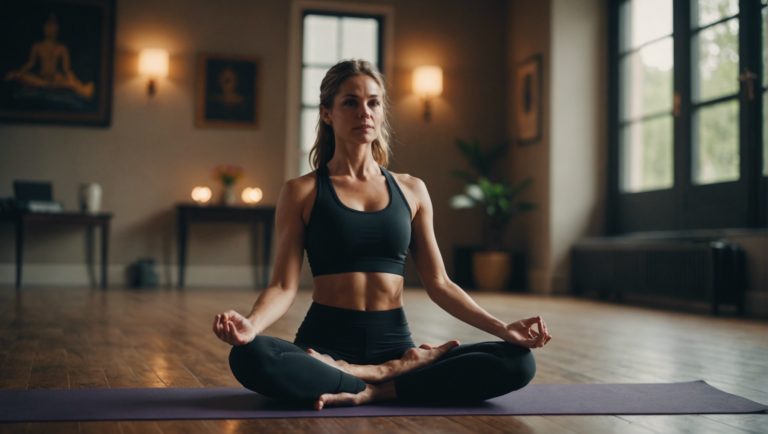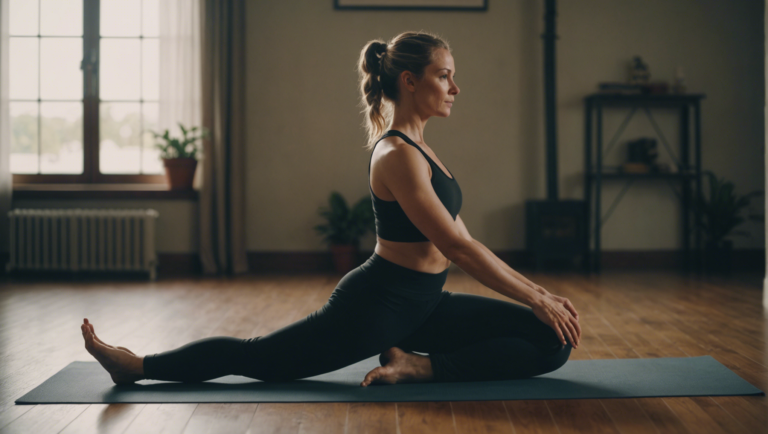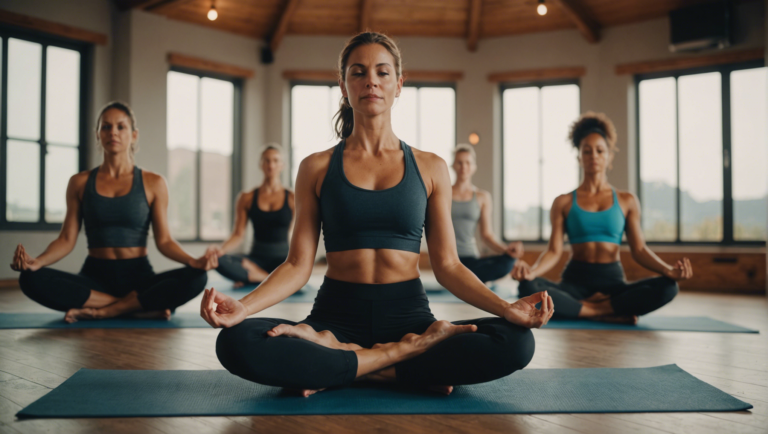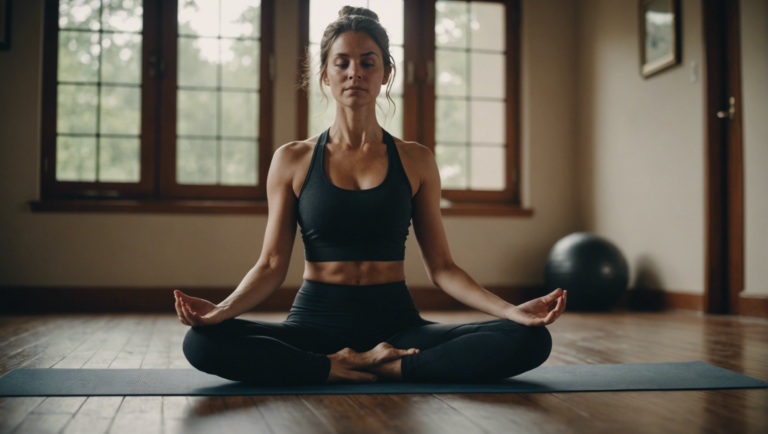Guidelines On Determining The Ideal Thickness For Your Yoga Mat
Factors to Consider When Selecting the Ideal Thickness for Your Yoga Mat
When it comes to practicing yoga, selecting the right mat is crucial for ensuring a comfortable and effective session. One of the key considerations in choosing a yoga mat is its thickness. The thickness of your yoga mat can significantly impact your practice by providing cushioning, support, and stability.
Importance of Yoga Mat Thickness
The thickness of your yoga mat plays a vital role in determining the level of comfort and support it offers during your practice. A thicker mat provides extra cushioning, which can be beneficial for those with sensitive joints or those practicing on hard surfaces. Thicker mats also offer more insulation from the floor, keeping you warmer during floor poses and meditation.
Factors to Consider When Choosing the Ideal Mat Thickness
1. Type of Yoga Practice
The type of yoga you practice can influence the ideal thickness of your mat. For example, practitioners of Hatha or restorative yoga may prefer a thicker mat for added comfort during poses that involve sitting or lying down. On the other hand, those practicing Ashtanga or power yoga, which involve more dynamic movements, may opt for a thinner mat to feel more connected to the ground.
2. Body Weight and Sensitivity
Your body weight and sensitivity levels are important factors to consider when selecting the thickness of your yoga mat. Heavier individuals may benefit from a thicker mat to provide ample support, while lighter individuals may find a thinner mat more suitable. If you have sensitive joints or require extra cushioning, a thicker mat is advisable.
3. Portability and Storage
Thicker mats tend to be heavier and bulkier than thinner ones, making them less portable and harder to store. If you travel frequently or attend yoga classes outside of your home, a thinner, lightweight mat may be more practical. Consider where and how you will be using your mat to determine the ideal thickness based on portability and storage needs.
Finding the Right Balance
Selecting the ideal thickness for your yoga mat ultimately boils down to finding the right balance between comfort, support, and practicality. It’s essential to test out different thickness options to see what feels most comfortable for your body and practice style. Remember that personal preference plays a significant role in choosing the perfect mat thickness.
The thickness of your yoga mat is a critical aspect to consider when enhancing your practice. By taking into account factors such as the type of yoga you practice, your body weight, sensitivity, and portability needs, you can determine the ideal thickness that best suits your individual requirements. Experiment with various thicknesses to find the perfect balance of comfort and support for a rewarding yoga experience.
The Relationship Between Yoga Mat Thickness and Comfort During Practice
Yoga practitioners often debate on what the ideal thickness for a yoga mat should be to achieve maximum comfort during their practice. The relationship between yoga mat thickness and comfort is crucial as it directly impacts the support and cushioning provided to the body during various poses and movements. Let’s delve deeper into the factors that influence the decision-making process when determining the most suitable thickness for your yoga mat.
Understanding the Importance of Yoga Mat Thickness
The thickness of a yoga mat plays a significant role in ensuring comfort and stability during yoga sessions. A thinner mat may provide a firmer surface, making balancing poses easier due to a closer connection to the ground. On the other hand, a thicker mat offers more cushioning, which can be beneficial for individuals with joint issues or those seeking additional support during their practice.
Factors to Consider When Choosing Yoga Mat Thickness
-
Type of Yoga Practice: The type of yoga you practice will impact the ideal thickness of your mat. For instance, practitioners of gentle or restorative yoga may prefer a thicker mat for added comfort during long-held poses, while those practicing dynamic styles like Ashtanga or Vinyasa may opt for a thinner mat for better stability in standing poses and transitions.
-
Body Weight and Pressure Points: Your body weight and pressure points also play a crucial role in determining the appropriate mat thickness. Heavier individuals or those with sensitive joints may benefit from a thicker mat to reduce discomfort and prevent injuries during practice.
-
Balance of Comfort and Stability: Finding the right balance between comfort and stability is key. While a thicker mat may offer more cushioning, it can also impact balance and stability during standing poses. Experimenting with different mat thicknesses can help you find what works best for your body and practice.
Guidelines on Determining the Ideal Thickness for Your Yoga Mat
-
Comfort Level: Pay attention to how your body feels during various poses on different mat thicknesses. Choose a thickness that feels comfortable and supportive for your unique needs and preferences.
-
Trial and Error: Don’t be afraid to try out different mat thicknesses to determine what works best for you. Borrow mats from friends or attend yoga classes that provide mats of varying thicknesses to test them out before making a purchase.
-
Consult with Instructors: Yoga instructors and practitioners with experience can offer valuable insights and recommendations on choosing the right yoga mat thickness based on your practice and body requirements.
-
Quality Over Thickness: Instead of focusing solely on thickness, prioritize the quality of the mat material. A high-quality, durable mat with the right thickness can provide the perfect balance of comfort, stability, and longevity.
The relationship between yoga mat thickness and comfort is a personal choice that depends on various factors such as the type of yoga practice, body weight, comfort preferences, and balancing stability. By understanding these guidelines and factors, you can make an informed decision to select the ideal thickness for your yoga mat that enhances your overall practice experience.
Comparing Different Thickness Options for Yoga Mats and Their Benefits
Yoga practitioners understand the importance of having the right equipment to enhance their practice. One key component of a successful yoga practice is the yoga mat. When it comes to choosing a yoga mat, thickness plays a crucial role in providing the comfort and support needed during various yoga poses and exercises. Different thickness options offer unique benefits, and understanding these differences can help practitioners determine the ideal thickness for their yoga mat needs.
Exploring Thin Yoga Mat Options
Thin yoga mats, typically around 1/16 inch thick, offer practitioners a close-to-the-ground feel. These mats provide a firm foundation for balance poses and are lightweight and easy to transport. Thin mats are ideal for individuals who prioritize portability and enjoy feeling connected to the ground during their practice. However, thin mats may not provide sufficient cushioning for practitioners with sensitive joints or those who require extra support during their practice.
Considering Standard Thickness Yoga Mats
Standard thickness yoga mats, usually around 1/8 inch thick, strike a balance between comfort and stability. These mats offer more cushioning than thin mats, making them suitable for a wide range of yoga styles and practitioners. Standard thickness mats provide adequate support for joint protection without compromising stability during standing poses. They are a popular choice for both beginners and experienced yogis looking for versatility in their practice.
Exploring Thick Yoga Mat Options
Thick yoga mats, typically around 1/4 inch thick or more, prioritize cushioning and comfort. These mats are ideal for individuals with sensitive joints, injuries, or those who prefer extra padding during their practice. Thick mats offer superior shock absorption, making them suitable for restorative yoga, Pilates, or any practice that involves prolonged periods of time on the mat. While thick mats provide excellent cushioning, they may be heavier and less portable compared to thinner options.
Determining the Ideal Thickness for Your Yoga Mat
When choosing the ideal thickness for your yoga mat, it is essential to consider your personal preferences, body type, and the type of yoga you practice. If you prefer a close-to-the-ground feel and prioritize portability, a thin yoga mat may be the right choice for you. For a balance of comfort and stability, a standard thickness mat is a versatile option suitable for most practitioners.
If you have sensitive joints, injuries, or require extra cushioning during your practice, a thick yoga mat may provide the support you need. Ultimately, the ideal thickness for your yoga mat is a personal decision that depends on your unique needs and preferences. By understanding the benefits of different thickness options and considering how they align with your practice, you can choose a yoga mat that supports you both physically and mentally during your yoga journey.
How Yoga Mat Thickness Impacts Balance and Stability in Poses
When it comes to practicing yoga, the thickness of your mat can play a significant role in your overall experience. The ideal thickness for your yoga mat can impact your balance and stability in various poses, influencing the effectiveness of your practice. Understanding how different thickness levels can affect your yoga routine is essential for choosing the right mat that suits your needs.
Importance of Yoga Mat Thickness
The thickness of your yoga mat is crucial as it provides cushioning and support during your practice. Thicker mats offer more padding, which can be beneficial for individuals with joint issues or those looking for extra comfort during poses that require kneeling or lying down. On the other hand, thinner mats provide a more stable surface for standing poses, allowing for better balance and alignment.
Impact on Balance
The thickness of your yoga mat directly affects your balance while performing different poses. Thicker mats create a softer surface that can make balancing more challenging as your feet and hands sink into the cushioning. This challenge can help improve your balance over time as you engage stabilizing muscles to maintain your position. In contrast, thinner mats offer a firmer foundation, making it easier to balance during standing poses but providing less comfort for floor-based poses.
Influence on Stability
Stability in yoga poses is closely related to balance, and the thickness of your mat can influence how stable you feel during practice. Thicker mats absorb more of your movement, which can make it harder to ground yourself and feel stable in dynamic poses. However, the extra cushioning can be beneficial for individuals with sensitive joints or those who prefer a softer surface. Thinner mats offer more stability, allowing for a firmer connection to the ground and enhanced stability in poses that require a strong foundation.
Finding the Ideal Thickness
Determining the ideal thickness for your yoga mat depends on your personal preferences and needs. If you prioritize comfort and joint support, a thicker mat (around 5mm to 6mm) may be suitable for your practice. This thickness level is ideal for individuals with injuries or those who spend a significant amount of time on the floor during their yoga sessions.
On the other hand, if you value stability and balance in standing poses, a thinner mat (around 3mm to 4mm) might be more appropriate. Thinner mats provide a firmer surface that promotes better traction and stability, especially in balancing poses that require a strong connection to the ground. Additionally, thinner mats are lighter and more portable, making them a convenient choice for yogis on the go.
The thickness of your yoga mat can have a significant impact on your balance and stability during practice. By considering your preferences, comfort level, and the types of poses you typically perform, you can choose a mat with the ideal thickness that enhances your yoga experience. Whether you opt for a thicker mat for extra cushioning or a thinner mat for better stability, selecting the right thickness is key to maximizing the benefits of your yoga practice.
Tips for Maintaining and Preserving the Quality of Your Yoga Mat
Maintaining your yoga mat is essential for both hygiene and longevity. Proper care of your mat can enhance your overall yoga experience and ensure that it lasts for years to come. Here are some effective tips for maintaining and preserving the quality of your yoga mat.
Regular Cleaning
Regular cleaning is crucial to keep your yoga mat free from dirt, sweat, and bacteria. After each practice session, wipe down your mat with a damp cloth or a yoga mat cleaning spray. You can make a natural cleaning solution using water, vinegar, and tea tree oil for a chemical-free option. Regular cleaning not only maintains the hygiene of your mat but also prevents it from developing an unpleasant odor.
Deep Cleaning
In addition to regular wipe-downs, it’s important to deep clean your yoga mat every few weeks. You can deep clean your mat by submerging it in a bathtub filled with a mixture of mild detergent and water. Gently scrub the mat with a soft brush, rinse thoroughly, and hang it to dry. Deep cleaning helps remove deep-seated dirt, oils, and sweat from your mat, keeping it fresh and prolonging its lifespan.
Proper Storage
Proper storage is key to preserving the quality of your yoga mat. Always roll up your mat with the top side (the side you practice on) facing outwards to prevent the corners from curling. Avoid storing your mat in direct sunlight or extreme temperatures, as this can damage the material. Invest in a yoga mat bag or a mat sling to keep your mat protected when not in use.
Avoid Harsh Chemicals
When cleaning your yoga mat, avoid using harsh chemicals such as bleach, alcohol, or heavy-duty cleaners. These chemical substances can break down the material of your mat and shorten its lifespan. Opt for natural cleaning solutions or specifically formulated yoga mat cleaners to maintain the integrity of your mat.
Rotate Your Mat
To prevent uneven wear and tear, make it a habit to rotate your yoga mat regularly. If you always practice in the same spot on your mat, it’s likely that certain areas will show signs of wear sooner than others. By rotating your mat, you can distribute the usage more evenly and extend its durability.
Air It Out
After cleaning or using your yoga mat, allow it to air dry completely before rolling it up for storage. Moisture trapped in a rolled-up mat can lead to mold and mildew growth, affecting both the quality of the mat and your health. Hang your mat over a railing or lay it flat in a well-ventilated area to ensure thorough drying.
By following these simple yet effective tips for maintaining and preserving your yoga mat, you can ensure that it stays in top condition for a long time. Taking care of your yoga mat not only benefits your practice but also contributes to a cleaner and more enjoyable yoga experience overall. With proper maintenance, your yoga mat can continue to support you in your practice for years to come.
Conclusion
In making a decision on the ideal thickness for your yoga mat, a multitude of factors come into play. It’s crucial to keep in mind the type of yoga you practice, your level of experience, any existing joint issues, as well as personal preferences regarding cushioning and stability. Thickness impacts various aspects of your practice, notably comfort, balance, and stability. Considering these elements will guide you towards choosing the most suitable yoga mat thickness for your needs.
When weighing the factors to consider when selecting the ideal thickness for your yoga mat, remember that thicker mats offer more cushioning for sensitive joints and provide extra comfort during longer practice sessions. On the other hand, thinner mats offer increased stability and a firmer connection to the ground, crucial for balance-focused practices like Ashtanga or Vinyasa.
The relationship between yoga mat thickness and comfort during practice is evident, as the thickness of your mat directly affects the level of support your joints receive during asanas. For individuals with sensitive knees or wrists, a thicker mat can significantly reduce discomfort and allow for a more enjoyable practice. Conversely, if you prioritize stability and balance in your practice, a thinner mat may be the way to go.
Comparing different thickness options for yoga mats and their benefits showcases the wide array of choices available to practitioners. From ultra-thin mats designed for portability and stability to plush, cushioned mats for maximum joint support, there is a mat thickness to suit every yogi’s needs. It’s essential to test out various options to determine which thickness best complements your practice style and preferences.
Understanding how yoga mat thickness impacts balance and stability in poses underscores the importance of selecting the right thickness for your specific needs. Thicker mats can provide a more forgiving surface for balance poses, while thinner mats offer a firmer foundation for grounding and stability. Experimenting with different thickness levels will help you find the perfect balance between cushioning and support for your practice.
To ensure the longevity and quality of your yoga mat, follow these essential tips for maintenance and preservation. Regularly clean your mat with a gentle mat cleaner or a mixture of water and vinegar to prevent the buildup of sweat and bacteria. Additionally, avoid leaving your mat in direct sunlight or extreme temperatures to prevent damage to the material. Rolling your mat rather than folding it will also help maintain its shape and integrity over time.
By taking into account these factors and tips, you can make an informed decision when selecting the ideal thickness for your yoga mat. Whether you prioritize comfort, stability, or balance in your practice, choosing the right thickness will enhance your overall yoga experience and ensure that your practice is both enjoyable and beneficial for your body and mind.



